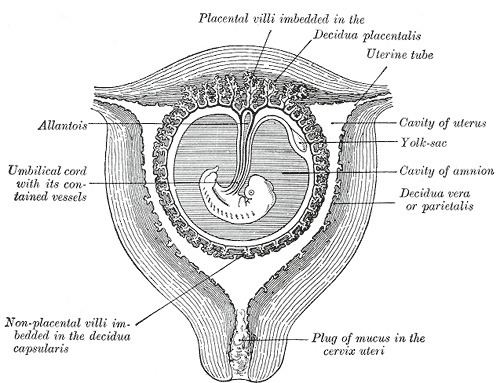MeSH A16.759.289 | Code TE E6.0.1.4.0.0.7 | |
 | ||
Decidua is the term for the uterine lining (endometrium) during a pregnancy, which forms the maternal part of the placenta. It is formed under the influence of progesterone and forms highly characteristic cells.
Contents
Etymology
The word comes from the Latin deciduus, meaning falling off or shedding.
Background
After ovulation, in placentalmammals, the endometrial lining becomes hypertrophic and vascular under the influence of oestrogens and progesterone.
In animals exhibiting hemochorial placentation, the endometrium then undergoes decidualization following implantation to form the decidua. If this does not occur, the secretory lining will be absorbed (estrous cycle) or shed (menstrual cycle).
The decidua is shed with the placenta during parturition.
Structure
The part of the decidua that interacts with the trophoblast is the decidua basalis (also called decidua placentalis), while the decidua capsularis, grows over the embryo on the luminal side, enclosing it into the endometrium. The remainder of the decidua is termed the decidua parietalis or decidua vera, and it will fuse with the decidua capsularis by the 4th month of gestation.
Three morphologically distinct layers of the decidua basalis can then be described:
Within the decidua, occasional fibrinoid deposits form where the syncytiotrophoblast is damaged. The region of fibrinoid deposition where trophoblasts meet the compact portion of the decidua basalis is called Rohr's layer, while the fibrinoid deposits that occur between the compact and spongy layer of the decidua basalis is termed Nitabuch's layer. This layer is absent in placenta accreta.
The decidua has a histologically-distinct appearance, displaying large polygonal decidual cells in the stroma. These are enlarged endometrial stromal cells, which resemble epithelium (and are referred to as "epithelioid").
Decidualization includes the process of differentiation of the spindle-shape stromal fibroblasts into the plump secretory decidual cells, which create a pericellular extracellular matrix rich in fibronectin and laminin (similar to epithelial cells).
Vascularity, as well as vascular permeability, is enhanced in the decidualizing endometrium.
Its leukocyte population is distinct, with the presence of large endometrial granular leukocytes being predominant, while polynuclear leukocytes and B cells are scant.
The large granular lymphocytes (CD56 bright) are called "uterine NK cells" or "uNK cells" in mice, and "decidual NK cells" or "dNK cells" in humans.
Role
As the maternal interface to the embryo the decidua participates in the exchanges of nutrition, gas, and waste with the gestation. It also protects the pregnancy from the maternal immune system. Further, the decidua has to allow a very controlled invasion of the trophoblast.
In invasive placental disorders like placenta accreta decidualization have been consistently found to be deficient.
Hormone production
The decidua secretes hormones, growth factors, and cytokines. It has receptors for estrogen, progesterone, growth hormone, and others.
Among its products are hormones commonly associated with other organs such as cortisol, CRF, GnRH, prolactin, and relaxin. Decidual prolactin is not under dopaminergic control.
Pregnancy protein 14 (PP-14), also called placental protein 12, and Insulin-like growth factor-binding protein 1(IGFBP1) appear to be specific products of the secretory and decidual lining.
Other factors released include interleukin-15 and vascular endothelial growth factor (VEGF). A reasonable understanding of the role and interplay of these hormones and factors has not been evolved.
Other
Pathology
A long-lasting infection of the decidua, chronic deciduitis, is associated with pre-term labour.
